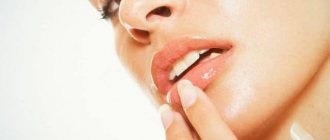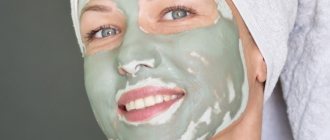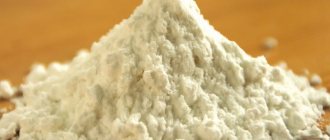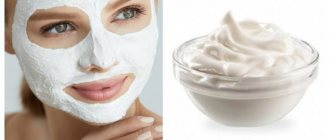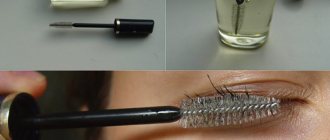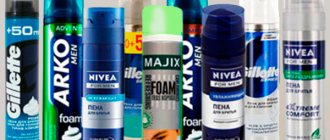Clay masks are one of the most popular and sought after skin treatments in home cosmetology. They are used by people of different ages, and even genders. It would seem that clay, in essence, is dirt, but we require cleansing of the skin. How, then, can these two factors be compared?
The fact is that clay is a specific mineralized rock that perfectly absorbs and retains moisture, unlike other rocks. With its help, you can not only deeply cleanse the skin and give it powerful detoxification, but also nourish it, moisturize, and smooth it. A mask based on it is loved by the fair sex all over the world, and their ages range from young to old. But, alas, like all good things, such a remedy requires dosed use.
What is cosmetic clay and why is it so useful?
This is a sedimentary rock based on kaolin. It is actively used in medicine as part of sorbent preparations, drugs for the treatment of gynecological diseases, and spa treatment.
Macaws are known to eat white clay to neutralize toxins found in unripe tropical fruits. Over the centuries-old history of using this cosmetic product, women have invented many ways to prepare masks. Clay is used either in its pure form or combined with egg yolk, sea salt, hydrogen peroxide, essential oils, and fermented milk products.
Classic clay mask recipe:
- Take 2 teaspoons of dry clay and mix it with 2 teaspoons of water.
- Apply a thick layer of the mixture.
- Wait 20 minutes and wash with warm water.
- Apply a light moisturizer.
- You can make a mask according to this “recipe” using clay of any color.
- Apply the mask correctly to clean skin. Wash your face before the procedure.
For acne
This mask can neutralize inflammation and cleanse the skin. It is recommended for use on porous, problematic and oily skin. To prepare, you will need a few drops of tea tree essential oil, 10 g of cosmetic clay, and 5 g of calendula flowers. The flowers must be thoroughly crushed, gray clay and antiseptic oil must be added to them. If there are no ulcers on the face, the epidermis should be steamed using a herbal compress. After this, the mask is evenly distributed over the face with a spatula. After 10 minutes, the clay must be washed off with a concentrated infusion of hibiscus. Reviews of gray clay prove that this product is ideal for eliminating acne.
How to determine what clay your skin needs?
This cosmetic product is selected in two ways: depending on the problems and skin type.
On the issue:
- Acne, comedones: yellow, blue, white.
- Pigmentation, freckles: blue.
- Enlarged pores: white and blue.
By skin type:
- Bold: white and blue.
- Dry: red and green clay.
- Prone to irritation, thin: red.
- Fading: green, blue, white, red.
- The effectiveness of clay masks depends not only on the properties of the clay, but also on the additional components included in their composition. . It can be used in combination with various components for both oily and dry dermis.
Rules for using clay masks
Sometimes on the Internet on women's forums, many people complain that after using a clay mask, their face turns red. This trouble is a consequence of violating the rules for using masks. The clay itself has an acid-base balance close to neutral, so it does not irritate the epithelium. In addition, it is an excellent antiseptic and can even relieve inflammation. It is also not an allergen. But other components of the mask (ethers, honey, etc.) can cause allergies.
- Therefore, rule No. 1 when using any cosmetic mask at home is to test for an allergic reaction. This also applies to kaolin masks. If you suspect that the cause of skin redness may be an allergy, take an antihistamine.
- The second reason may be incorrect application of the product, exceeding the permissible exposure time, or excessively frequent procedures. In this case, you should urgently apply moisturizer to your face, and also carefully study the recommendations for using clay masks at home.
How many times a week can you make a clay mask?
How often to make a clay face mask depends on the type of dermis:
- oily dermis allows you to make kaolin masks twice a week;
- For normal and combination skin, weekly use of masks is recommended;
- For owners of dry epithelium, the procedure should be performed only twice within a month with a two-week break between them.
The reason is that clay is able to absorb not only dirt and fat, it also takes moisture from the epithelium. Therefore, to the question whether it is possible to make a clay mask every day, the answer will be clearly negative. Even if you have very oily skin, it also needs moisture.
In particularly advanced cases, it is allowed to make kaolin masks every other day at first, but after two weeks the regularity of sessions should change, the interval between them should be at least two days.
Application rules
Knowing how to properly apply a clay mask to your face will quickly achieve the desired results. If the application rules are not followed, undesirable consequences may occur: redness, peeling, feeling of dryness and tightness.
For application to the skin, only a product with a consistency such as thick sour cream is suitable:
- if it is thinner, it will begin to flow, lay down in a thin layer, dry quickly, as a result, the effect of its use will be insignificant, and the risk of irritation of the epithelium will increase;
- if it turns out to be thicker, it will dry out very quickly, tightening the skin, and will begin to take moisture from it, and besides, it will be more difficult to remove such a mask.
Kaolin masks are applied either with a brush or with clean fingers - the latter option is even more convenient. The layer should be quite dense.
Exposure time
How long to keep a clay mask on also depends on your skin type:
- for dry skin, exposure time should not exceed five minutes;
- with normal, mixed, it can be doubled;
- for oily skin – up to 15-20 minutes, but usually a quarter of an hour is enough.
During the procedure, it is better to be in the bathroom, and if the humidity in the room is low, it is recommended to moisturize the mask from time to time by spraying your face with mineral water from a spray bottle.
How to properly remove a clay mask
After the required time, the mask must be removed. To do this, you need to moisturize it by spraying it or placing wet palms on your face for a while. When the product gets wet, you need to remove it completely with a damp cloth, and you can wash it.
If, after the face is completely dry, a feeling of tightness of the skin appears, then the situation can be corrected with the help of a dermal care cream of the appropriate type.
Video on how to properly apply and remove face masks with clay:
White clay face mask
White clay masks are rich in silicon, aluminum, zinc, calcium and other beneficial substances. They are used for different types of skin to deep clean pores and increase its elasticity.
White clay relieves itching and inflammation, whitens the skin, lightens age spots on the face and evens out skin color. It also smoothes out small scars and irregularities (scars and post-acne). This cosmetic product has an antiseptic and moderate drying effect, so it can be used on dry facial skin without fear of dehydration.
Types of clay for masks
In clay masks you can find clay of different colors: red, white, blue, green, black. Differences in color are due to the presence of chromophore substances (for example, iron oxide and copper oxide).
- Ghassoul (rhassoul) is a Moroccan clay from the Atlas Mountains, known for rituals for the face and body in the hammam. Record holder for calcium and magnesium content, which means it strengthens and soothes the skin.
- Bentonite (montmorrilonite) is a clay native to the city of Benton in Arkansas (USA). Known as a strong absorbent, as well as a substance with powerful lightening properties. One of the favorite components in cosmetics for oily skin.
- Kaolin is a white clay named after its discovery in the Chinese village of Gaolin. The main substance kaolinite (aluminum silicate) is a good absorbent with a mild cleansing effect. Kaolin masks are suitable for all skin types.
- Blue (gray) clay - it owes its color to algae, which are known for their lifting and anti-pigment abilities.
- Green clay is rich in zinc, silver and phosphorus. Removes oily shine, mattifies the skin, corrects the functioning of the sebaceous glands.
- Red clay - soothes the skin, relieves irritation, moisturizes, improves blood flow in capillaries. When red clay is mixed with kaolin, pink clay is obtained - the most delicate, which is suitable even for sensitive skin.
Blue clay face mask
This product is used to combat acne, inflammation, irritation and redness. Blue clay masks stimulate the production of collagen and elastin in dry skin. They tone and tighten the skin of the face and neck, and are also applied to the décolleté area. Clay of a bluish tint promotes healing and restoration of the skin, relieves inflammation in clogged pores, and cleanses them.
Mask against acne and blackheads:
- 2 teaspoons blue clay powder;
- 2 tablespoons of chamomile decoction;
- 1 cucumber;
- 1 aloe leaf.
The natural shade of dry powder is grayish. If a store sells a ready-made mask of a rich blue color, it contains artificial dyes.
Nutritional composition
This mask can restore cell membranes, prevent the formation of wrinkles, and smooth out existing wrinkles. Such procedures are recommended for women over 40 years of age. To prepare the mask, you need to melt one teaspoon of coconut oil. Add one spoon of cosmetic clay and one chilled quail egg to the resulting mixture. To obtain a uniform consistency, the composition can be beaten with a mixer. Apply the mask to the face with a plastic spoon using light tapping movements. The product is washed off the face with linden tea 20 minutes after application.
Black clay face mask
Black clay masks are dry powder of volcanic origin, dark gray in color. This clay is high density. It feels greasy to the touch. It helps well against acne, dullness and sagging skin, fine wrinkles. Also, masks based on this powder are good for inflammation.
Black clay removes toxins from the epidermis and relieves flaking. It is actively used in cosmetology in the fight against cellulite and fat deposits in the abdomen and thighs. Hair masks are also made from it to restore its structure after frequent dyeing and styling.
Acne mask:
- clay - 2 spoons;
- decoction of string - 3 tablespoons;
- lemon juice - 1 teaspoon.
Recipe No. 1 – Mask for oily skin
A white clay mask improves the condition of oily and problematic skin. With regular use, the pores are cleansed of impurities, the skin becomes fresh and acquires a healthy, even glow.
Ingredients
- White clay: 1 tbsp;
- Starch: 1 tbsp;
- Milk: 2-3 tbsp.
Features of preparing and using the mask
Making a mask begins with thoroughly mixing clay and starch. To achieve optimal consistency, milk is added to the mixture. Its volume is calculated “by eye”: the mask should not be too liquid so as not to spread over the face.
The mask should be kept on the face for 10 minutes and then washed off with cool water. If you have combination skin type and your cheeks are dry, then you should not apply the mask to these areas. It is better to limit yourself to wiping them with a cotton pad dipped in milk.
A starch-based mask in combination with white clay and milk gives a triple effect. Starch normalizes the condition and color of the skin. This substance is known for its rejuvenating and calming effect. Milk saturates the skin with vitamins and stimulates regenerative processes.
Red clay face masks
This substance is of volcanic origin. Red clay is rich in copper, iron, magnesium, and silicon. Natural color ranges from red-brown to purple or grayish. This cosmetic product actively removes excess oil from the skin, gently drying it. A red clay mask removes old age spots, comedones, acne, refreshes fading dermis, and gets rid of rosacea. It is highly absorbent.
Recipe for dry skin:
- 13 gr. red clay;
- 18 gr. sour cream (15%);
- 2-3 raspberries.
Benefits of clay for dry and sensitive skin
The main property of kaolin is excellent cleansing, and everyone needs it, regardless of the type of epidermis.
Dry skin does not tolerate various scrubs well, since even with the smallest abrasive particles they injure the epidermis. At the same time, a keratinized layer of dead cells also accumulates on it, and in this case kaolin is perfect.
Cosmetic clay for dry skin is useful because it removes dead cells no worse than scrubs and peels, while it acts gently and does not damage the epidermis.
Speaking about what kind of clay is for dry skin, it should be noted that it is not so much the type of product that is important, but how it is used.
Green clay face mask
Green clay masks are known for their healing and cosmetic properties. Potassium, silicon, zinc and aluminum, as well as copper contained in its composition restore the water balance of the skin, stimulate the normalization of metabolic processes, and make the skin fresh and youthful.
Green clay eliminates swelling, improves the condition of hair, body and even strengthens nails.
Green clay mask for blackheads:
- 2 tablespoons of dry powder;
- lemon juice 3 tablespoons;
- vodka 10 ml.
Precautionary measures
Natural cosmetic clay for the face has virtually no contraindications other than individual intolerance and allergies. But it’s still worth noting a few rules if you use facial clay at home.
- Apply it to cleansed dermis
- Do not let the mask tighten too much and thereby damage the skin
- If applied in a thin layer and it dries quickly, moisten it with water or spray a clay mask
- If you feel any discomfort, wash it off without waiting for the specified time.
- Do not use lemon juice if there is damage.
Facial clay is a valuable natural product that will help in caring for problematic, oily, aging skin. If you want to rejuvenate, inspire, and improve the appearance of your dermis, facial clay will be the best solution.
Pink clay face mask
Pink clay is the result of combining red and white. The resulting product is distinguished by its delicate effect and universal properties. It is suitable for girls with oily skin and those with dry and thin skin. The product stimulates the regeneration process, soothes, and tightens pores where necessary. It actively removes impurities from pores, heals microcracks and damage, smoothes the skin surface, and has a rejuvenating effect.
Pink clay mask for dry skin:
- pink clay powder;
- milk;
- 1 tablespoon cottage cheese;
- a tablespoon of natural honey.
Cleansing composition
This mask whitens, tightens pores, removes purulent formations, and soothes inflammation. It is recommended to perform the procedure no more than 3 times a month in order to prevent the formation of age spots and wrinkles. To prepare the product you will need 10 g of cosmetic clay, a few drops of sage essential oil, 1 tablet of activated carbon. The sorbent should be steamed with a warm decoction, then mixed with gray clay and medicinal oil. Before applying the mask, the skin is steamed using a compress. The composition is applied with rubbing movements for 10-15 minutes. Clay is removed from the face with water mixed with grapefruit ether.
How to choose cosmetic clay for dry skin: which one is suitable
The varieties of cosmetic clay presented on store shelves differ not only in color, but also in the effect they have on the skin of the face. So, for oily or combination skin types, masks with a drying effect are suitable, while for dry skin such products are strictly contraindicated by cosmetologists. For sensitive epidermis, clay with a matting effect is recommended to be used exclusively in diluted form. Therefore, you need to choose the right clay for your skin type, otherwise it may cause irritation or have the opposite effect.
To do this, add to the masks:
- nourishing oils;
- herbal decoctions;
- chopped fruits;
- dairy products;
- honey;
- egg yolk.
Pink and red clays provide the most gentle care for dry skin. Both types are distinguished by their delicate consistency, due to which the delicate removal of keratinized epithelial cells occurs.
Pink clay has a regenerating effect, increases blood flow in the tissues of the skin, thereby saturating the skin with essential nutrients and oxygen.
White, green and blue cosmetic clays can be applied in diluted form. Such products affect the production of the sebaceous glands, thereby reducing the amount of sebum secreted.
On oily or combination skin types, products with a similar effect work much better than on dry, flaky skin. That is why, before using clay with a drying effect, it is additionally diluted with various natural ingredients or oils. You can find out which facial clay is the most effective here.
When giving preference to one type or another, do not forget to take into account two important factors:
- Clay deposit. The area where the rock was mined must comply with environmental standards. Only clay that does not contain harmful toxic substances and heavy metals will be useful.
- Composition of the product. Some manufacturers make the mistake of producing low-quality clay, giving the powder the desired shade using various chemical dyes. Such products not only cause harm, but also stain the skin, after which it is necessary to cleanse the face in other additional ways.
Pay special attention to the composition of the clay from which you make cosmetics.
White
White clay, or, as it is also called, kaolin, is used primarily in the care of oily skin. Dry bluish or yellow powder is mixed with a small amount of water to obtain a plastic, creamy consistency.
White clay has a beneficial effect on mature skin. Homemade masks based on kaolin and nourishing oils well moisturize the epidermis, thereby helping to smooth out fine expression wrinkles. The whitening effect of white clay allows you to get rid of age spots in the shortest possible time, and the rich silicon content promotes increased collagen production in the upper layers of the dermis.
White clay cleanses pores of impurities, relieves inflammation, and effectively whitens red spots after acne.
Clay masks should not be left on dry facial skin until completely dry. Otherwise, the mask will take all the moisture from the epithelium and dry out sensitive skin even more. To prevent the clay from hardening during the procedure, periodically spray your face with thermal water or any hydrosol.
Red
The soft texture of the mask is very gentle on dry skin. Red clay perfectly relieves redness, eliminates itching, flaking and gives the face a healthy, radiant appearance. The powder contains a large amount of copper and iron, which have an intense restorative effect.
Unlike other types, red clay does not dry out the sensitive epidermis, which is prone to flaking.
Red clay perfectly cleanses accumulated impurities, removes dead cells and has a pronounced antiseptic effect.
Pink
It is obtained by mixing white and red clay. These masks effectively fight the first signs of aging thanks to the rich content of kaolinite, illite and calcium. You can learn about the properties and uses of pink clay in this material.
A successful combination of two powders is used as a delicate scrub. Clay peeling cleanses clogged pores, thereby eliminating problematic skin from comedones, blackheads, and various skin rashes.
Masks based on pink clay tone the skin well and affect blood flow in the upper layers.
Green
It affects very deep layers of the dermis, resulting in thorough cleansing of the skin. Green clay is very popular in cosmetology. You can learn more about the properties and uses of green clay here.
Green clay masks demonstrate several effects at once:
- tighten aging mature skin;
- intensively nourish dehydrated epidermal cells;
- have a tonic effect.
The healing properties of green clay allow you to restore the natural hydrolipid balance of the skin, nourish cells with useful substances and smooth out fine wrinkles.
Cosmetic clay should not be diluted in metal containers. During the mixing process, the metal reacts with the powder, which negatively affects the subsequent effect of the cosmetic procedure.
Gray
Based on gray clay, various masks and creams are produced that have a pronounced lifting effect. Systematic use of such products promotes skin rejuvenation, relieves puffiness and improves complexion. The delicate consistency of gray clay absolutely painlessly cleanses the skin of impurities, and the potassium and zinc contained in it help actively remove harmful toxins.
Despite this, gray clay has managed to gain popularity in the cosmetology industry due to its concentrated composition and effective anti-aging effect.
Gray clay is considered the rarest type, since the rock is mined at the bottom of the sea.
Yellow
It got its name due to the yellow tint of the rock, which was formed due to the presence of potassium and iron in the composition. These microelements have pronounced antioxidant properties and also remove toxic substances from epidermal cells.
Yellow clay is suitable not only for dry sensitive skin, but also for oily skin due to its bactericidal, antiseptic and wound-healing effects on the dermis. This product perfectly moisturizes dehydrated epithelial cells, and its pronounced regenerating properties help fight microcracks, peeling and redness of the skin. Find out about the properties and uses of yellow clay by following the link.
Yellow clay has a tonic effect.
Popular recipes
Here are some of the most effective recipes that can be used for rejuvenation at home.
Rejuvenating
A rejuvenating anti-wrinkle mask made from white clay is suitable for those with normal to combination skin. For preparation you will need a fermented milk product (kefir for oily skin or sour cream for normal skin), as well as aloe juice.
You can prepare this product yourself. To do this, the bottom leaf of the plant is washed, dried and placed in the vegetable compartment in the refrigerator, first wrapped in parchment. After ten days of exposure, you need to cut off the spines and skin from the inside of the leaf. Using a spoon, collect the pulp and squeeze it through cheesecloth. One mask will require a teaspoon of this valuable product.
Stir a couple of tablespoons of white clay in the fermented milk product, achieving a fairly thick creamy mass, then pour in the juice and mix. The composition is ready.
Lifting effect
This composition is especially recommended for use after the age of 50, as it not only smoothes out wrinkles, but also effectively tightens, providing a lifting effect.
Take green clay and potato starch, one spoon at a time, mix. Mix with a spoonful of thick sour cream (fat content 20% or higher) and one whipped egg white. After removing the composition, be sure to apply a moisturizer.
Smoothing
This composition effectively nourishes and smoothes out fine wrinkles. It is prepared using blue clay. Take a spoonful of flower honey and heat it a little in a water bath so that the product becomes more plastic, but heats up too much. Pour a spoonful of clay and pre-pounded yolk into warm honey, mix everything thoroughly.
Eliminate wrinkles on the forehead
An effective clay mask against wrinkles on the forehead is prepared on the basis of cosmetic white kaolin and olive oil. It is necessary to heat the oil to 40 degrees and mix it with clay so that a fairly thick mass is obtained.
Before applying the composition, you need to lie down. Apply a fairly thick layer to the forehead, cover with a paper towel, a piece of cling film, and place a thick terry towel on top. After 20 minutes, remove the composition; it is advisable to use chamomile infusion rather than water.
For excessive dryness
On skin prone to dryness, wrinkles begin to form at a young age. To prevent their appearance and eliminate existing wrinkles, it is recommended to use the following recipe:
- grind the yolk of a chicken egg, adding to it a boatload of freshly prepared applesauce (grate a piece of fresh apple on the finest grater);
- Pour a spoonful of red clay and half a teaspoon of jojoba oil into the prepared mass, rub everything until smooth.
Tonic
To give your skin tone and healthy color, you can use the following composition:
- First you need to prepare an infusion of chamomile, place a tablespoon of dry raw materials in a glass and fill half the container with boiling water. Cover the dish with a saucer and let cool;
- filter the infusion, carefully squeezing out the plant material;
- take a couple of spoons of yellow clay and dilute it with infusion so that you get a mass similar in thickness to sour cream;
- add half a teaspoon of avocado oil and rub.
Cleansing and eliminating wrinkles
To prepare this composition we use black cosmetic clay. For dilution we use milk (if the skin is dry or normal) or a decoction of St. John's wort (if the skin is prone to oiliness). Pour in enough liquid to form a creamy mass. Additionally, add half a teaspoon of wheat germ oil to the mixture. This composition perfectly renews the skin, the face looks younger after the first procedure.
Nourishing
This option is suitable for skin prone to flaking. We will need pomegranate, as well as essential and base oils. First, prepare a mixture of oils; to do this, pour a tablespoon of almond oil, a teaspoon of shea butter and five drops of lemon or blood orange ether into a bowl.
Separately prepare pomegranate juice (a tablespoon) and mix it with red clay until a thick mass is obtained. Then add a mixture of oils to the mixture and grind.
Nutrition and elasticity
This is a very simple but powerful anti-aging composition. You only need three ingredients - natural sea buckthorn oil, yolk and yellow clay. Mix them until the consistency of cream is obtained, add the yolk and knead until smooth.
Effective prevention
This composition can be used to prevent the formation of wrinkles after 25 years. To prepare the composition, it is recommended to use pink clay. To dilute the product we use milk or cream. We choose the last option if the skin is dry. Do this preventive procedure weekly, conduct courses twice a year.
To relieve irritation
If rashes and redness often appear on the skin, then the following composition will help solve the problem and smooth out fine wrinkles.
- “Hercules” flakes (choose cereals that need to be cooked for at least 20 minutes, quick-cooking cereals and those that brew millet with boiling water will not work) The cereal needs to be ground into flour using a coffee grinder, we will need a spoonful of this flour.
- The clay is green, we will take twice as much of it as oatmeal;
- Mix the two dry ingredients and dilute them with warm milk until you get the consistency of sour cream. Let it brew for about half an hour. If the mass has thickened too much, add a little more milk;
- Just before application, add five drops of tea tree ether and stir.
To level the terrain
Oily, porous skin does not look very beautiful; to make it more even and smooth, it is worth conducting a course of masks using a composition based on gray clay.
It is necessary to beat the protein to a strong foam and mix it with a spoon of kefir and gray clay. Add clay to the mixture little by little, achieving the desired consistency. When the mass acquires the thickness of sour cream, the mask can be applied. If you add the contents of two capsules of pharmaceutical vitamins Aevit to the prepared mass, the effect will be even more pronounced.
Indications for use of clay
Using clay you can solve many cosmetic skin problems, including:
- eliminate excess greasiness;
- reduce the number of rashes and inflammations;
- remove peeling;
- preserve moisture in the cells, that is, prevent drying out and the formation of wrinkles;
- provide cell nutrition with minerals;
- speed up metabolic processes;
- smooth out facial and age wrinkles;
- restore elasticity and natural contours.
| Showbiz news In a new interview, Sofia Rotaru shared her amazing secrets of beauty, long youth and creative plans. Read more… |
What's the benefit?
The beneficial properties of clay for the skin have been known since ancient times. It is part of a variety of cosmetics, including homemade masks.
Cosmetic clay is a natural product that is ideal for skin care of any type . It contains many useful minerals that not only rejuvenate, but also heal the skin. Thanks to the rich composition of the main component, a clay face mask increases elasticity, stimulates collagen synthesis, and evens out the relief.
The main ingredient of clay is silicon oxide. This substance has the most beneficial effect on the walls of blood vessels. This improves blood circulation, cell nutrition, and also stimulates their regeneration.
In addition, clay contains large amounts of magnesium . This active component eliminates unwanted pigmentation (freckles, post-acne, age spots), and also smoothes out wrinkles. Copper is another active component of clay; thanks to this trace element, collagen production is stimulated.
| Showbiz news Chinese Candy Lo is a woman who has completely conquered aging. At 52 years old, she continues to act and make plans for her life. What is the secret of her eternal youth? Read more… |
Varieties
In any cosmetics store, customers will be offered several varieties of clay. The general properties of all products are the same, but since the composition of different options is still different, before starting the procedures you should decide which type of clay will suit you best.
White
This type of product is ideal for caring for oily skin with enlarged pores. Masks with the addition of a white variety of clay allow you to mattify the skin, as they have a beneficial effect on the functioning of the skin glands that produce oil.
In addition, masks tighten pores, so the skin looks smoother and more beautiful.
Blue
The blue product is the best choice for those with problem . This product has powerful antiseptic and anti-inflammatory properties. In addition, the cosmetic product normalizes metabolic processes, so the skin acquires a healthy appearance and normal tone.
Clay has proven itself to be an excellent product for rejuvenation; this type of cosmetic product quickly smoothes out small expression wrinkles.
Green
It is used to restore water balance , so it is also suitable for dry skin. In addition, the green product perfectly evens out skin texture and smoothes out wrinkles.
Red
This is one of the products for rejuvenation; with the help of masks you can improve elasticity, tone and remove wrinkles . The red product is suitable for use on sensitive skin; it relieves irritation and inflammation well.
Pink
Has a moisturizing and nourishing effect , recommended for use on normal and combination skin. It perfectly rejuvenates and moisturizes.
Yellow
By choosing this product for a course of masks, you will provide your skin with toning and nutrition . In addition, this type of clay relieves inflammation and irritation well, and also improves complexion.
Gray
This product is called marine because it is mined from the bottom of the sea. It has a special composition, nourishes and moisturizes well , and is suitable for ladies with dry skin.
Black
This type of clay contains high levels of iron. Therefore, masks based on it stimulate blood circulation and perfectly cleanse pores. It gently removes dead cells no worse than the most expensive scrub, so your face will look younger after completing the course.
| This Chinese grandmother amazed the whole world with her amazing beauty. But she is over 50... Read more... |
How to use
If you buy ready-made clay masks, use them strictly according to the instructions, since such products may contain additional ingredients, and if you do not follow the recommendations, you will not get the expected effect.
If you prefer pure clay without any additives, then using this clay for the face is very simple: you need to dilute it, optionally add the components necessary for your skin, and apply a mask to the skin.
We will talk about how to dilute clay for the face and what additives are needed later.
The composition must be diluted in a glass or plastic container, stirred with a wooden or plastic spoon.
It is advisable not to brew the clay with boiling water, but to dilute it with warm water or water at room temperature. If you use clay for deep cleansing or as compresses, then warm water is preferable.
How to prevent the mask from drying out on your face
Since it is very important not to let the clay dry out, try to follow these rules:
- Do not leave the clay on your face too long. 15 minutes for a mask is quite enough, especially if it is an astringent, drying or tightening mask.
- Apply clay in a thick layer. Where it is applied thinly, you may see red spots and peeling. Try to avoid this.
- Apply the mask in the bathroom, where humidity is higher.
- During the procedure, spray the composition from a spray bottle, or cover the mask with a damp gauze cloth.
- Add base oils to the mixture, so the composition will dry out more slowly.
How to use for dry skin
Despite prejudices, you can use clay for the face and dry skin. To do this, the clay is diluted with heavy cream or hydrosols, base oils are added, you can also mix in honey, aloe juice, and pollen.
Before applying the clay, lubricate the area around the eyes and lips with a rich base oil. For example, wheat germ works very well.
For dry skin, clay is diluted as follows: first with water to a dry paste, then oil is added to the composition: usually a teaspoon per mask is enough. Instead of butter, you can use cream.
If you add essential oils, be sure to dilute them in an emulsifier: this could be honey, base oils, cream, sour cream.
Red face after clay
Sometimes after clay you get a red face. What is this connected with? Most likely, not with the clay itself, but with the way it is used. Clay is a neutral product and usually does not cause any allergic reactions.
Most likely, you overexposed the clay to your face; in this case, you need to moisturize your skin well (apply a moisturizing mask or cream).
Another possible cause of a red face is the composition of the mask. This reaction can occur to kefir, high concentrations of essential oils, and honey. Review the composition of your mask and remove additives that could cause redness.

